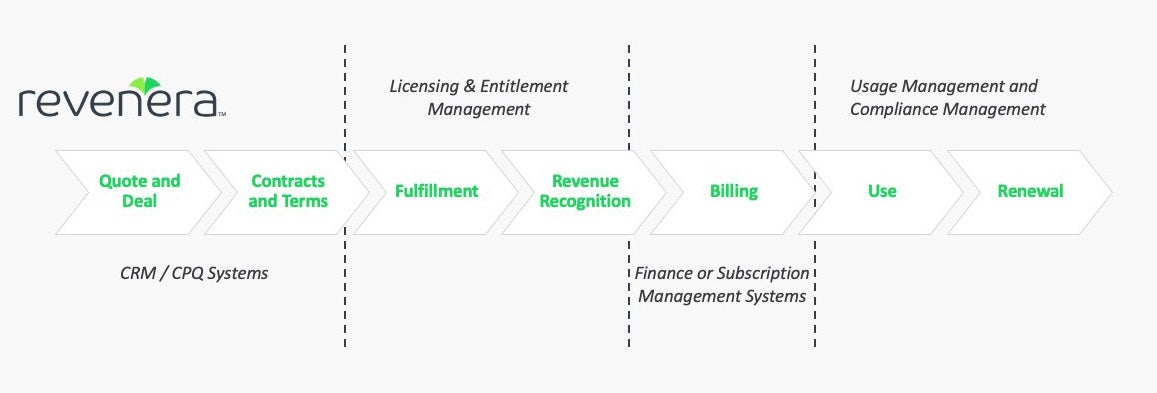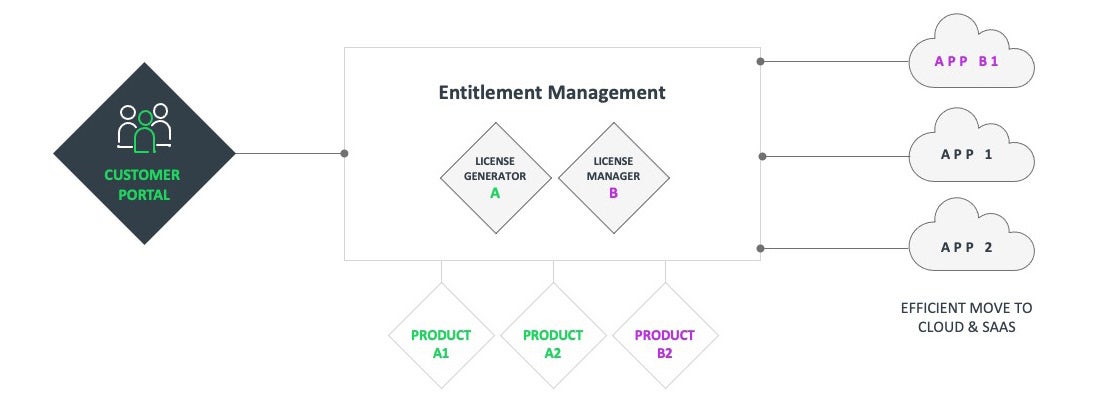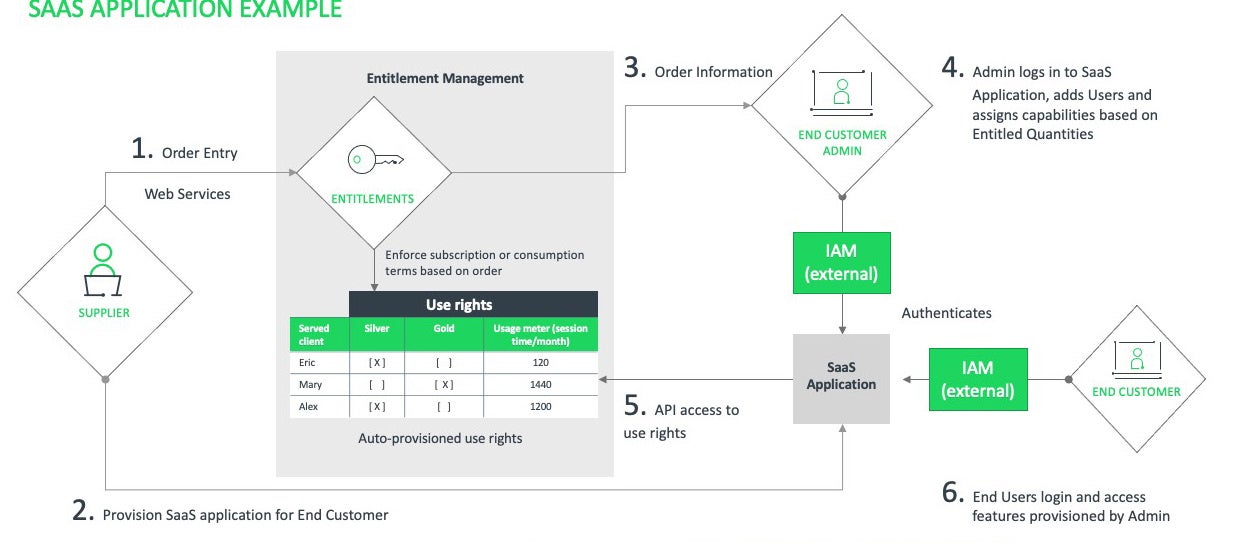Guide
The Product Manager's Ultimate Guide to Successful SaaS Implementation
Software companies are moving to software-as-aservice (SaaS) faster than ever before. SaaS provides a better customer experience and represents how buyers want to buy today. However, software companies should not underestimate the long tail of their on-premises solutions that still deliver a good share of the overall revenue.
In this world of hybridized software models, subscription public cloud services, including SaaS and platform-as-a-service (PaaS), are growing much more rapidly than subscription on-premises deployments. As forecasted by IDC, subscription revenue from public cloud services will grow from $240.9 in 2020 to $570.1 billion in 2025, far surpassing subscription revenue from on-premises software ($117.1 billion in 2020 growing to $244.5 billion in 2025).
With the swift shift to SaaS comes the need for effective management of all offerings—whether a software supplier or intelligent device company is adding its first SaaS product, expanding its SaaS applications, building SaaS application platforms that communicate back to on-premises applications, or looking for more effective and efficient ways to manage multiple software deployment models. Not only do these objectives depend on effective entitlement management, they require clarity into how the software is being used. Gathering accurate usage data is a top priority for software product managers. Today, 70% of suppliers collect usage data, up from 60% in 2020; the number of software suppliers collecting usage data is expected to grow to a total of 79% by 2023. This growing trend helps deliver insights required to manage SaaS offerings and improve the overall experience for users. Usage data is not only important for SaaS, but it’s especially valuable when transitioning on-prem apps to SaaS to define how to do it best and align pricing and value.
Insight
“52% of software vendors offer both public cloud and on-premise software (hybrid).”
–IDC 2
SaaS implementation is most successful when product managers and operations teams take a comprehensive look at their software offerings. The ultimate goal is to ensure that customers have an excellent overall experience.
This requires delivering self service capabilities so that customers can manage entitlements/use rights across the organization, get transparency into usage data, and support channel partner relationships for effective delivery of SaaS offerings. This guide looks at the technical considerations to support those initiatives.
Understand Entitlements
There’s much more to SaaS than just authenticating a user and logging that user into an application, including many things that support software monetization. Efficient entitlement management requires clarity into the varied information that an entitlement holds. This then facilitates the successful operation of a SaaS business, with flexible and hybrid monetization models, new packaging and pricing models, and streamlined processes for provisioning and fulfillment across product offerings.
A software supplier typically has multiple systems in its quote-to-cash process: enterprise resource planning (ERP), customer relationship management (CRM), billing, and business intelligence (BI). Information from these systems (such as the order) feeds into the entitlement system to show what the end customer bought and the terms of what the customer bought (e.g, duration, monetization model, volume, and other terms). The entitlement system enforces or fulfills that order so that the software application (SaaS or on-premises) can deliver appropriate access.
As users interact with the software, the entitlement system maintains important insights of how the software is consumed. This provides the software supplier with an audit trail of information that can easily be extracted from the supplier’s analytics or entitlement system to demonstrate how end-customers enter the application and consume licenses. This information, which eventually needs to go into the billing system, is maintained by the entitlement system.
An entitlement may change over time for two main reasons. First, if there is a new order of products or services. The second reason for changed entitlements is when an end customer moves around and needs to change what they have rights to in order to support the work they’re doing within their organization. In either case, self-service capabilities in an entitlement system streamlines these changes.
As software vendors transition to SaaS, they’re able to offer a single way to interact with an entitlement system, whether those entitlements are for new SaaS applications or for other applications, such as desktop and mobile applications. These user-based applications facilitate great flexibility, allowing the user to communicate with an entitlement system and see exactly what entitlement use rights they have, no matter where they’re accessing the applications.
DEFINITION
Software Entitlement
A software entitlement is the right to use software. A software entitlement is typically purchased for the use of particular software, and enables software vendors to manage software usage, monitor license compliance and maintain product data.
Support the Entire Quote to Cash Process
Multiple back office systems need to work together in order to monetize SaaS. Looking at it from a business process perspective, evaluate and support the entire quote to cash (revenue recognition) process.
QUOTE TO CASH: BUSINESS PROCESS AND SYSTEMS

Systems commonly used include:
A CRM system, or the configure, price, quote (CPQ) functionality of a CRM system, is always involved. This holds the amount for the quote and the stock-keeping units (SKUs) for the products and services that the customer intends to purchase.
The moment that this order closes and a prospect becomes a customer is when licensing and entitlement management kicks in. The SKUs move from being line items on a customer quote to being active entitlements, identifying the rights associated with the software (including the number of users or amount of usage, as determined by the monetization model). When it gets pinged by the end application, entitlement management makes this information available. The system knows what the customers have the rights to use. Customers can then start doing self-services to set up their users and use rights, based on what was purchased.
The accounting system then kicks in for billing. A relatively easy model is a flat-fee subscription, in which the customer pays the same amount ($10 per month, $100 per year or $1 million per year, for example) in each billing cycle. With SaaS models, the flat fee subscription frequently also has a usage-based component, which is very often updated on a monthly basis. Whether it is using a prepaid or postpaid model, the software supplier needs to identify actual usage, which is captured in the entitlement management system in order to be pushed to the finance system. These steps ensure that software producers track what customers owe, then invoice appropriately.
Usage management and compliance management track usage and compliance, supporting the enforcement strategy of the software supplier. This can also support the overall lifecycle by tracking movement from trial or freemium to paid usage. It offers a compliance component to protect from overuse, comparing entitled usage to actual usage, supporting resolution strategies (i.e., moving the customer to a higher usage tier or changing the contract).
Deploy a Central Monetization Strategy
As companies move to SaaS as part of an overall digitization trend, many seek to align back office systems. Managing products in silos—with different processes for different product lines—increases complexity and operational overhead (e.g., for reconciliation of what customers own), creating potential issues, including for revenue recognition.
These silos make it difficult to answer a CEO’s question of “How is our software business doing?” Product managers must be able to report up, demonstrating increasing revenue, greater customer satisfaction and higher product adoption levels. Being able to report on these metrics and trends requires a single system of record.
INSIGHT
When processes are different per product line, overhead may grow and it may create issues with revenue recognition. Instead, streamline and align processes across areas, including product management, orders, operations, and finance.
Instead of relying on a siloed approach, get a complete view of what customers own. Running a central entitlement management back-office can help suppliers strengthen their SaaS offerings and their digital transformation initiatives, overall.
A central monetization strategy is useful for systems that span multiple products. It can manage entitlements directly communicating with SaaS applications, serve licenses to on-premises applications and interact with local license servers that can be used in air-gapped environments. Integrate fulfillment technologies into your entitlement system. All the systems that your customer interacts with, paired with those customers’ entitlements, can provide the data required for the software supplier’s intelligence reporting. This provides useful, accurate data for customers and channel partners, as well.
CENTRAL MONETIZATION STRATEGY AND SYSTEMS ACROSS PRODUCTS

Having one single source of truth is a huge advantage for all parties involved. Modern software companies are focused on annual recurring revenue (ARR), customer churn, profitability and how usage of software is increasing or decreasing. Reporting on these metrics consistently across product lines can help address common business challenges, including how to accelerate recurring revenue, make roadmap and pricing decisions, shorten time to value for new products, and stop revenue leakage. This allows SaaS companies, looking for competitive differentiation, to monetize valuable features, changing packaging, pricing and functionality much more frequently than was common in the past.
Bring Agility Beyond Homegrown Solutions
Different software suppliers have different approaches to SaaS licensing. To give users access to the system and enforce use rights, it is possible to rely on a homegrown approach by hard coding the logic and functionality within the SaaS application itself.
Yet the limitations of this approach become clear when a supplier expands the SaaS offering and needs to accommodate the features and capabilities of new products and packaging. The SaaS product supplier/publisher needs to remain focused on its core competencies and not be weighed down by the resources required to build modern entitlement and licensing. When inhouse teams try to handle the entitlement and licensing, though, those efforts often tax the limited engineering resources and hamper product managers’ teams to be agile and innovative. Homegrown solutions often delay the time to market and prevent suppliers from implementing the monetization models they need. Furthermore, any in-house development of entitlements/ licensing is a valuable software feature for the core product that is not developed.
More efficiently, a centralized entitlement management system (illustrated below in the gray box) that manages usage rights can communicate with the SaaS application to determine what users own and have rights to. The SaaS application then accesses this entitlement management system, which handles fulfillment of and provides access to products and services coming from an order system.
SAAS LICENSING EXAMPLE

This structure enables users to self-service different packages and products. The end-customer administrator can match users in their enterprise with different capabilities within the SaaS application (e.g., allocating a particular amount of monthly usage), with those use rights being maintained by the entitlement system itself (not within the SaaS application).
Frequently Asked Questions (FAQs)
SaaS implementation refers to the process of deploying software-as-a-service solutions, including planning, configuring, and integrating cloud-based applications. It involves technical setup, entitlement management, and ensuring a seamless user experience for customers.
Entitlement management ensures users have the correct access rights to software features and services. It helps vendors monitor usage, maintain compliance, and streamline billing, which is crucial for effective SaaS operations and customer satisfaction.
SaaS monetization involves generating revenue through subscription models, usage-based billing, and feature packaging. Centralized systems help track entitlements and usage, enabling flexible pricing and recurring revenue streams for software suppliers.
Challenges include aligning back-office systems, managing hybrid deployments, ensuring data security, and adapting to new billing models. Overcoming these requires strategic planning and robust entitlement management solutions.
Product managers can enhance SaaS adoption by focusing on customer experience, collecting usage data, and offering self-service capabilities. Streamlining processes and providing clear value propositions also drive higher product adoption rates.
The quote-to-cash process covers everything from initial customer quotes to billing and revenue recognition. Integrating CRM, entitlement, and accounting systems ensures accurate tracking and efficient monetization in SaaS businesses.
Usage data provides insights into how customers interact with software, helping companies optimize features, align pricing, and improve user experience. It’s essential for making informed business decisions and driving growth.
A central monetization strategy means managing all product entitlements and billing through a unified system. This approach streamlines reporting, reduces operational overhead, and enables software suppliers to track recurring revenue, customer churn, and product adoption more effectively. It also helps prevent revenue leakage and supports agile pricing and packaging decisions.
SaaS companies often maintain both cloud-based and on-premises solutions to meet diverse customer needs. Effective entitlement management systems allow seamless integration and tracking of usage across deployment models, ensuring customers have the right access and vendors can monitor compliance and value delivery.
Product managers can leverage guides, webinars, and research reports from industry leaders like Revenera to stay informed about SaaS trends, monetization strategies, and technical considerations. These resources provide actionable insights for successful SaaS adoption and ongoing optimization.
Resources
Case Study
a.i. solutions® Launch Flexible Licensing to Accelerate Growth
See how they saved two years in development time, reduced support tickets by 500%, and continue to grow.
Industry Report
Forrester Total Economic Impact Study
Learn More About 426% ROI and Operational Efficiencies Enabled by Revenera
Case Study
Toon Boom Drives Double-Digit Growth with Streamlined Monetization Processes
The implementation of the new licensing and entitlement management solution resulted in several tangible benefits for Toon Boom.
Case Study
InnovMetric Expands User Base and Grows Recurring Revenue with Floating Licenses
By integrating FlexNet Publisher into the heart of its quote-to-cash framework, InnovMetric has consistently grown recurring revenue with a flexible go-to-market strategy.
Webinar
Untangling the Software Monetization Stack in a Usage-Based Economy
Tuesday, June 17, 2025
Hear from guest speaker Lily Varon, Principal Analyst at Forrester, as she discusses the impact of AI on software monetization solutions and how they’re delivered. Learn how you can identify where your business might have overlap or inefficiencies, and what you can do to ensure your business stays ahead of the curve.
Case Study
Growing Recurring Revenue Through Flexible Software Monetization Models
Eaton implemented Revenera’s Software Monetization solutions, including Entitlement Management and Software Licensing to centralize its platform management for licensing. It is achieving efficiencies and savings by streamlining software operations across multiple divisions and systems.
Want to learn more?
See how Revenera's Software Monetization platform can help you take products to market fast, unlock the value of your IP and accelerate revenue growth.